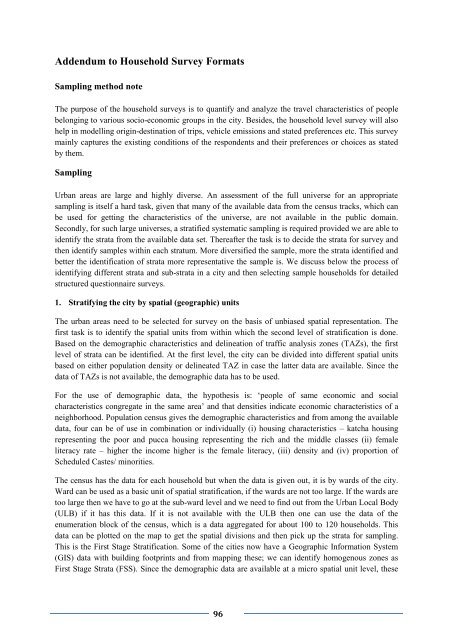Toolkits for Urban Transport Development - UNEP
Toolkits for Urban Transport Development - UNEP
Toolkits for Urban Transport Development - UNEP
Create successful ePaper yourself
Turn your PDF publications into a flip-book with our unique Google optimized e-Paper software.
Addendum to Household Survey Formats<br />
Sampling method note<br />
The purpose of the household surveys is to quantify and analyze the travel characteristics of people<br />
belonging to various socio-economic groups in the city. Besides, the household level survey will also<br />
help in modelling origin-destination of trips, vehicle emissions and stated preferences etc. This survey<br />
mainly captures the existing conditions of the respondents and their preferences or choices as stated<br />
by them.<br />
Sampling<br />
<strong>Urban</strong> areas are large and highly diverse. An assessment of the full universe <strong>for</strong> an appropriate<br />
sampling is itself a hard task, given that many of the available data from the census tracks, which can<br />
be used <strong>for</strong> getting the characteristics of the universe, are not available in the public domain.<br />
Secondly, <strong>for</strong> such large universes, a stratified systematic sampling is required provided we are able to<br />
identify the strata from the available data set. Thereafter the task is to decide the strata <strong>for</strong> survey and<br />
then identify samples within each stratum. More diversified the sample, more the strata identified and<br />
better the identification of strata more representative the sample is. We discuss below the process of<br />
identifying different strata and sub-strata in a city and then selecting sample households <strong>for</strong> detailed<br />
structured questionnaire surveys.<br />
1. Stratifying the city by spatial (geographic) units<br />
The urban areas need to be selected <strong>for</strong> survey on the basis of unbiased spatial representation. The<br />
first task is to identify the spatial units from within which the second level of stratification is done.<br />
Based on the demographic characteristics and delineation of traffic analysis zones (TAZs), the first<br />
level of strata can be identified. At the first level, the city can be divided into different spatial units<br />
based on either population density or delineated TAZ in case the latter data are available. Since the<br />
data of TAZs is not available, the demographic data has to be used.<br />
For the use of demographic data, the hypothesis is: ‘people of same economic and social<br />
characteristics congregate in the same area’ and that densities indicate economic characteristics of a<br />
neighborhood. Population census gives the demographic characteristics and from among the available<br />
data, four can be of use in combination or individually (i) housing characteristics – katcha housing<br />
representing the poor and pucca housing representing the rich and the middle classes (ii) female<br />
literacy rate – higher the income higher is the female literacy, (iii) density and (iv) proportion of<br />
Scheduled Castes/ minorities.<br />
The census has the data <strong>for</strong> each household but when the data is given out, it is by wards of the city.<br />
Ward can be used as a basic unit of spatial stratification, if the wards are not too large. If the wards are<br />
too large then we have to go at the sub-ward level and we need to find out from the <strong>Urban</strong> Local Body<br />
(ULB) if it has this data. If it is not available with the ULB then one can use the data of the<br />
enumeration block of the census, which is a data aggregated <strong>for</strong> about 100 to 120 households. This<br />
data can be plotted on the map to get the spatial divisions and then pick up the strata <strong>for</strong> sampling.<br />
This is the First Stage Stratification. Some of the cities now have a Geographic In<strong>for</strong>mation System<br />
(GIS) data with building footprints and from mapping these; we can identify homogenous zones as<br />
First Stage Strata (FSS). Since the demographic data are available at a micro spatial unit level, these<br />
96
















